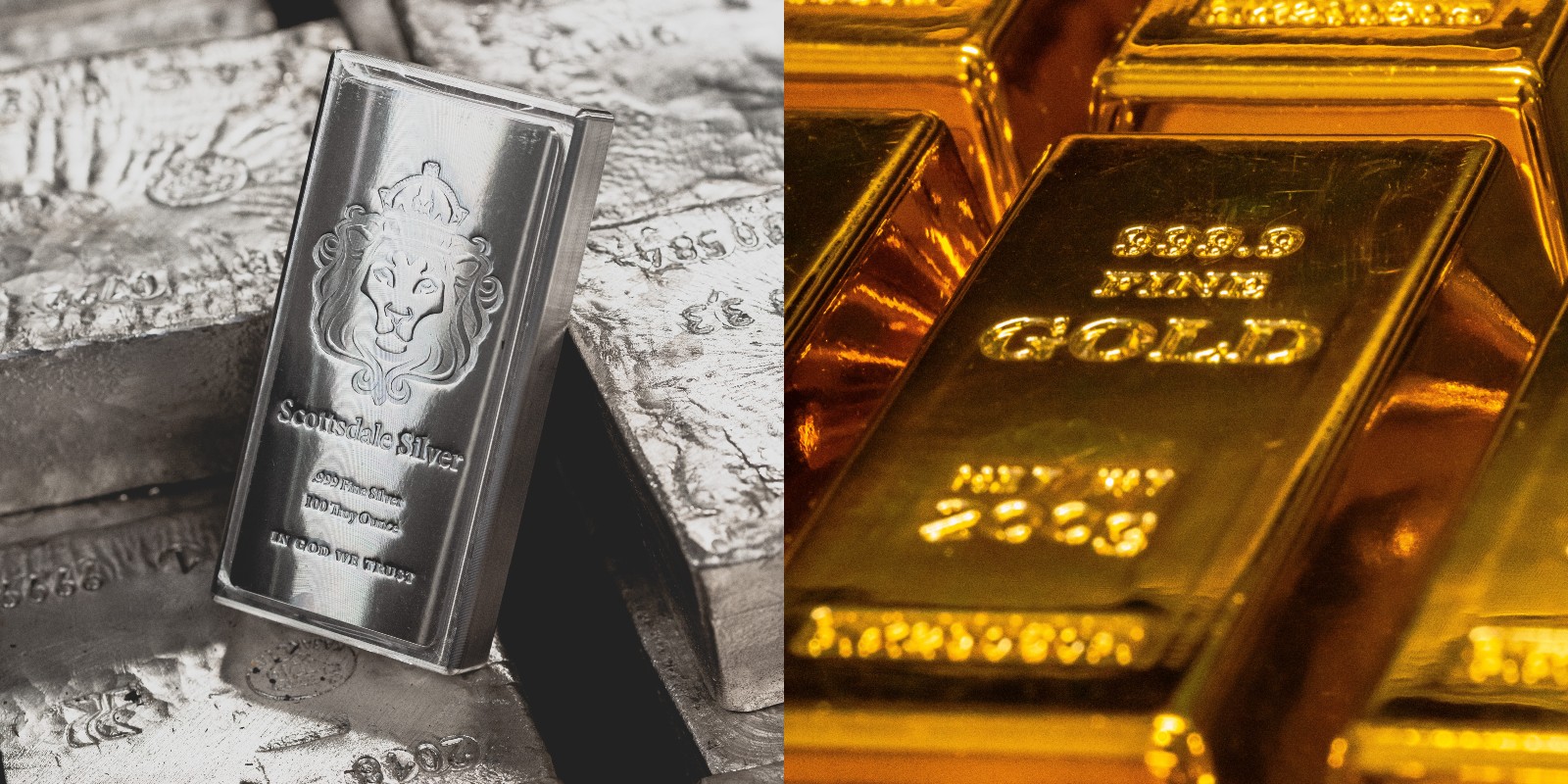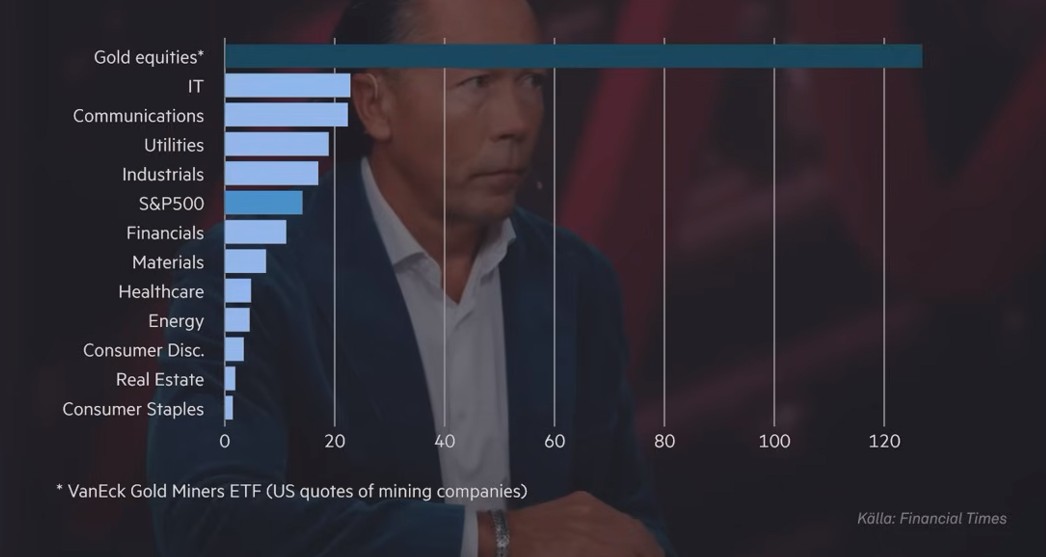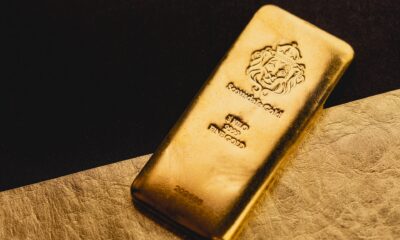Nyheter
David Hargreaves about precious metals, week 4 2012
 The sector remains as ever hostage to gold. Noted, the Pt/Au ratio is moving back in favour of platinum, but that might be as much to the woes of its mining grounds, RSA and Zim as anything else. And silver? The Au/Ag ratio, at 52 tells us the short-lived up-bursts of 2011, which saw it briefly clip $50/oz, will not be repeated. It would take a magnetic pull by gold to do that. Do we see one? Nobody objects to gold being in therapy, but it should at least stick with the same shrink for awhile. Mercifully, consensus views on its likely price extremes have narrowed, but they all concentrate on its highs. The upper end is now for it to “touch” $2500/oz before end 2012 but the authoritative CFMS opts more for $2000. The long shots say that if we crank up an economic recovery into 2013 then it will subside. None of this can accommodate the fears that might become reality.
The sector remains as ever hostage to gold. Noted, the Pt/Au ratio is moving back in favour of platinum, but that might be as much to the woes of its mining grounds, RSA and Zim as anything else. And silver? The Au/Ag ratio, at 52 tells us the short-lived up-bursts of 2011, which saw it briefly clip $50/oz, will not be repeated. It would take a magnetic pull by gold to do that. Do we see one? Nobody objects to gold being in therapy, but it should at least stick with the same shrink for awhile. Mercifully, consensus views on its likely price extremes have narrowed, but they all concentrate on its highs. The upper end is now for it to “touch” $2500/oz before end 2012 but the authoritative CFMS opts more for $2000. The long shots say that if we crank up an economic recovery into 2013 then it will subside. None of this can accommodate the fears that might become reality.
The Euro crisis has been taken on board, so even a Greek default will not signal a panic, at best a flutter. Iran and an oil blockade. That would, whatever its outcome, create conditions for a spike. Chinese and Indian buying. We are becoming ever more reliant on these two sources, together mustering 40% of the world’s people, with rising spending power and an appetite for portable collateral.
We shall see a $1400/oz downside tested this year, we think.
Petropavlovsk (PDG, FTSE 690p Hi-Lo 1090p – 543p) produces its Q4 results on Jan 26th. It is targeting 600,000 oz for the 2011 year from its Russian gold operations. It did 447,200 oz to September, so has an achievable target. It has fallen with the sector this past year, but is tipped by Shares Magazine, a recommendation we endorse.
Cluff Gold (AIM CLF 90p up 20% Hi-Lo 126p-65p) enjoyed a strong rise this week coincident with its news of ‘significant’ new sulphide deposits at its Yaoure mine on the Ivory Coast. The company has other West African interests, is a producer and has driven management, notwithstanding the tribulations of the region.
Platinum still does not know why it is at a discount to gold. Production problems in RSA and Zimbabwe tightening the screws make supply vulnerable. The auto industry is burgeoning, so why the poor price performance? The push for production in South Africa’s Bushveld Complex did cause excess supply fears. The switch towards diesel cars means more palladium (thus Russia’s stockpile) and the move towards hybrids and bio fuels less of both catalytic ingredients.
But the industry has troubles a-plenty looming. Zimbabwe is threatening increased export royalties as well as indigenisation. The major companies are suffering through the double whammy of massive wage increases and a falling metal price. As a result Amplats, world No 1 at 36% of total production, warns of a 60%-70% plunge in 2011 basic earnings. It had been expecting “at least” $1800/oz in the year. Today it stares at $1530. It also lost its CEO, David Brown, abruptly and without a trailing reason. The earnings fall will impact on Anglo American, which holds 79% of Amplats. Some say a 2% hit.
RSA and Economic Zones. Perhaps with the distraction of Mr. Malema now sidelined, the country can get on with efforts to keep itself at the forefront of mining development. It is a slot it deserves. We note in Bulk Minerals its determination to maximise its silica industry. Now something similar is professed for platinum. A Special Economic Zone (SEZ) is proposed which will encompass nor only mining and refining but manufacturing and technology. They speak of fuel cells. Amplats is right behind this one and we would put our money on Johnson Matthey being not far behind.
Russia’s Polyus Gold, 37% owned by billionaire M. Prokhorov, sees no problem in the Russian Government allowing him to list in London. He is a close associate of V. Putin and has his eye on the Presidency too. A point to consider given recent exposés (eg ENRC): He might want London, but will London want him?
Lonmin, the world’s No.3 platinum miner has done a small but strategic private placing ($2.5M) with Canadian explorer Wallsbridge (LMI.L 1032p; Hi-Lo 1930-932p). It already holds 10.8M shares in the group which targets, in particular, PGMs in the Sudbury area of Canada. Wallbridge also has J/Vs with Xstrata and Impala Platinum.
India Ups Its Gold Import Duties. The world’s largest importer upped its gold duty 90% and doubled the tax on silver last week. At 2% and 6% respectively it is clearly not meant to dampen enthusiasm but to raise government revenues.
[hr]
About David Hargreaves
David Hargreaves is a mining engineer with over forty years of senior experience in the industry. After qualifying in coal mining he worked in the iron ore mines of Quebec and Northwest Ontario before diversifying into other bulk minerals including bauxite. He was Head of Research for stockbrokers James Capel in London from 1974 to 1977 and voted Mining Analyst of the year on three successive occasions.
Since forming his own metals broking and research company in 1977, he has successfully promoted and been a director of several public companies. He currently writes “The Week in Mining”, an incisive review of world mining events, for stockbrokers WH Ireland. David’s research pays particular attention to steel via the iron ore and coal supply industries. He is a Chartered Mining Engineer, Fellow of the Geological Society and the Institute of Mining, Minerals and Materials, and a Member of the Royal Institution. His textbook, “The World Index of Resources and Population” accurately predicted the exponential rise in demand for steel industry products.
Nyheter
Vad guldets uppgång egentligen betyder för världen

Guldpriset har nyligen nått rekordnivåer, över 4 000 dollar per uns. Denna uppgång är inte bara ett resultat av spekulation, utan speglar djupare förändringar i den globala ekonomin. Bloomberg analyserar hur detta hänger samman med minskad tillit till dollarn, geopolitisk oro och förändrade investeringsmönster.
Guldets roll som säker tillgång har stärkts i takt med att förtroendet för den amerikanska centralbanken minskat. Osäkerhet kring Federal Reserves oberoende, inflationens utveckling och USA:s ekonomiska stabilitet har fått investerare att söka alternativ till fiatvalutor. Donald Trumps handelskrig har också bidragit till att underminera dollarns status som global reservvaluta.
Samtidigt ökar den geopolitiska spänningen, särskilt mellan USA och Kina. Kapitalflykt från Kina, driven av oro för övertryckta valutor och instabilitet i det finansiella systemet, har lett till ökad efterfrågan på guld. Även kryptovalutor som bitcoin stiger i värde, vilket tyder på ett bredare skifte mot hårda tillgångar.
Bloomberg lyfter fram att derivatmarknaden för guld visar tecken på spekulativ överhettning. Positioneringsdata och avvikelser i terminskurvor tyder på att investerare roterar bort från aktier och obligationer till guld. ETF-flöden och CFTC-statistik bekräftar denna trend.
En annan aspekt är att de superrika nu köper upp alla tillgångsslag – aktier, fastigheter, statsobligationer och guld – vilket bryter mot traditionella investeringslogiker där vissa tillgångar fungerar som motvikt till andra. Detta tyder på att marknaden är ur balans och att kapitalfördelningen är skev.
Sammanfattningsvis är guldets prisrally ett tecken på en värld i ekonomisk omkalibrering. Det signalerar misstro mot fiatvalutor, oro för geopolitisk instabilitet och ett skifte i hur investerare ser på risk och trygghet.
Nyheter
Spotpriset på guld över 4300 USD och silver över 54 USD

Guldpriset stiger i ett spektakulärt tempo, nya rekord sätts nu på löpande band. Terminspriset ligger oftast före i utvecklingen, men ikväll passerade även spotpriset på guld 4300 USD per uns. Guldet är just nu som ett ångande tåg som det hela tiden skyfflas in mer kol i. En praktisk fördel med ett högre pris är att det totala värdet på guld även blir högre, vilket gör att centralbanker och privatpersoner kan placera mer pengar i guld.
Även spotpriset på silver har nu passerat 54 USD vilket innebär att alla pristoppar från Hunt-brödernas klassiska squeeze på silver har passerats med marginal. Ett högt pris på guld påverkar främst köpare av smycken, men konsekvensen av ett högt pris på silver är betydligt mer kännbar. Silver är en metall som används inom många olika industrier, i allt från solceller till medicinsk utrustning.
Nyheter
Guld och silver stiger hela tiden mot nya höjder

Priserna på guld och silver stiger hela tiden mot nya höjder. Eric Strand går här igenom vilka faktorerna som ligger bakom uppgångarna och vad som kan hända framöver. Han får även kommentera aktier inom guldgruvbolag som har haft en bättre utveckling än nästan allt annat. Han säger bland annat att uppgången kommer från låga nivåer och att det i genomsnitt är en mycket högre kvalitet på ledningarna för bolagen idag.
-

 Nyheter3 veckor sedan
Nyheter3 veckor sedanOPEC+ missar produktionsmål, stöder oljepriserna
-

 Nyheter4 veckor sedan
Nyheter4 veckor sedanEtt samtal om guld, olja, fjärrvärme och förnybar energi
-

 Nyheter2 veckor sedan
Nyheter2 veckor sedanGoldman Sachs höjer prognosen för guld, tror priset når 4900 USD
-

 Nyheter2 veckor sedan
Nyheter2 veckor sedanGuld nära 4000 USD och silver 50 USD, därför kan de fortsätta stiga
-

 Nyheter3 veckor sedan
Nyheter3 veckor sedanBlykalla och amerikanska Oklo inleder ett samarbete
-

 Analys4 veckor sedan
Analys4 veckor sedanAre Ukraine’s attacks on Russian energy infrastructure working?
-

 Nyheter4 veckor sedan
Nyheter4 veckor sedanGuldpriset uppe på nya höjder, nu 3750 USD
-

 Nyheter3 veckor sedan
Nyheter3 veckor sedanEtt samtal om guld, olja, koppar och stål











